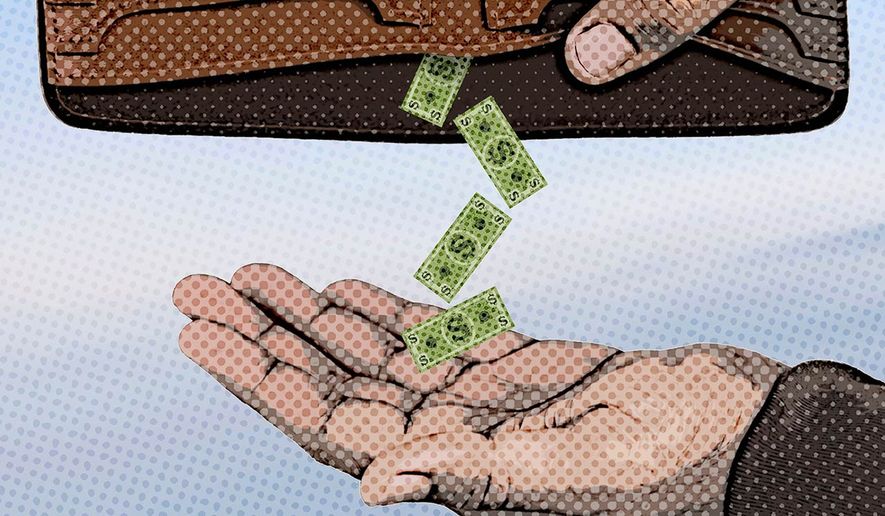OPINION:
The Federal Reserve’s pause in interest rates hikes opens the door to stagflation.
Going into the June policymaking meeting, analysts made a big deal about how the Fed, over 14 months, implemented the sharpest rates increases in recent memory. But challenges to growth and inflation have been much tougher lately than in the 1990s, 2000s and 2010s.
COVID-19 shutdowns imposed a lot more unemployment than the 2008 global financial crisis. And instead of comparing recent Fed policies against those implemented over a period of mostly tame inflation, it would be better to measure the Fed of Chairman Jerome Powell Fed against the Paul Volcker regime.
In the wake of the pandemic and $4.6 trillion in federal stimulus spending, largely enabled by Mr. Powell’s Fed printing money to finance the new debt, year-over-year inflation jumped to 9.1% in June 2022. The Fed responded by raising the federal funds rates to 5.1% by May.
After the promiscuous regimes of Chairmen Arthur Burns and William Miller and the pressures created by an aggressive OPEC oil cartel, inflation jumped to 14.8% in March 1980. Volcker responded by pushing the federal funds rate to 19.1% by June 1981.
That brought inflation down below 4% by the end of 1982. The economy suffered a tough recession but unfortunately, as inflation expectations once raised are tough to lower and Fed credibility once lost is difficult to find again, inflation averaged 3.7% for the next three years.
Mr. Powell puts a great deal of stock in consumer expectations, and that’s a good thing.
Consumers are also workers, business owners and investors. Where consumers believe inflation is headed influences the wages workers demand and employers offer, mortgage rates new homeowners feel comfortable paying and investors expect to finance those loans through mortgage-backed securities, and how higher interest rates will affect investor perceptions of the potential returns on high-tech growth stocks.
According to Mr. Powell, long-term inflation expectations remain well anchored, but consumers, homebuyers and investors negotiate and make decisions on how they see things now and a year hence.
Further down the road, economic decisions can be revisited.
Expectations as measured by the bond market — the difference between what ordinary one-year Treasuries and inflation-adjusted Treasuries pay — have widely undershot recent inflation.
Consumer surveys have generally been better predictors of future price increases. The Conference Board survey of consumer attitudes pegs inflation over the next 12 months at 6%, and the University of Michigan survey pegs them at 4.6%.
Those are well above the Fed’s 2% inflation target.
Four times a year, members of the Fed policymaking committee are asked for the short- and long-term forecasts for growth in gross domestic product, employment, inflation, and the future path of the Fed funds rate.
Suffice it to say their forecasts have consistently underestimated future inflation, but so have the ruminations of professional economists.
At the most recent meeting, the consensus of Fed policymakers again adjusted upward their outlook for inflation, net of volatile energy and food prices, and the trajectory for future federal funds rates.
The problem is that consumers, businesses and equity investors would like lower interest rates but as measured against expected inflation, current rates are not terribly high.
As a consequence, home sales, construction and prices are rebounding, tech stocks, which are interest rate sensitive, surged after the Fed’s pause decision, and wages, according to the Atlanta Fed, are rising at 6% a year.
The most recent headline inflation report was subdued because gas prices were lower. But core inflation, which was 5.5% in January, scored at 5.3%, according to the most recent print.
Economists are expecting some let up in inflation from falling rents on apartments and what homeowners could get leasing out their dwellings, but we have been hearing that for months.
Each month, the Bureau of Labor Statistics surveys one-sixth of its panel of renters and homeowners. I have run the math using Zillow indexes and lower rents from last October to January should have started showing up by now.
The BLS cost of shelter was up 8% in May.
A pause now with promises of more interest rate increases in the future reflected more the split among Fed policymakers between hawks and doves than good inflation-fighting policy — the decision gave everyone something they wanted, but no one was really happy.
Mr. Powell reminds us that stable prices are essential for healthy growth and good jobs, and inflation benefits no one.
Then-President Donald Trump delivered 2.6% growth and low inflation prior to the pandemic — decidedly better than the Fed’s growth forecast of about 1% for this year and next and 1.8% long term.
In the months ahead, we could still see some dips in inflation thanks to rents, but over the next few years, inflation in the range of 4% is likely. With growth at less than 2%, that’s stagflation.
• Peter Morici is an economist and emeritus business professor at the University of Maryland, and a national columnist.




Please read our comment policy before commenting.